Taxation Law Homework: Assessment of Tax Scenarios and Income
VerifiedAdded on 2020/02/18
|11
|2555
|39
Homework Assignment
AI Summary
This assignment delves into various aspects of Australian taxation law, providing detailed answers to two key questions. Question 1 analyzes ten different tax scenarios, determining whether specific incomes are taxable or deductible based on established tax rulings. The analysis covers fringe benefit tax, damage payments, gifts, club funds, income from sports performance, building apprentice expenditures, education expenses, artist expenditures, travel expenses, and official travel expenses. Question 2 focuses on calculating the assessable income, taxable income, and tax payable for an individual named Manpreet, considering gross salary, foreign income, and deductions. The solution includes a comprehensive table outlining the financial calculations and a discussion on the deductibility of certain expenses, referencing relevant sections of the Income Tax Assessment Act and supporting case laws like Lunney v. FC of T and Ronpibon Tin NL v. FC of T.
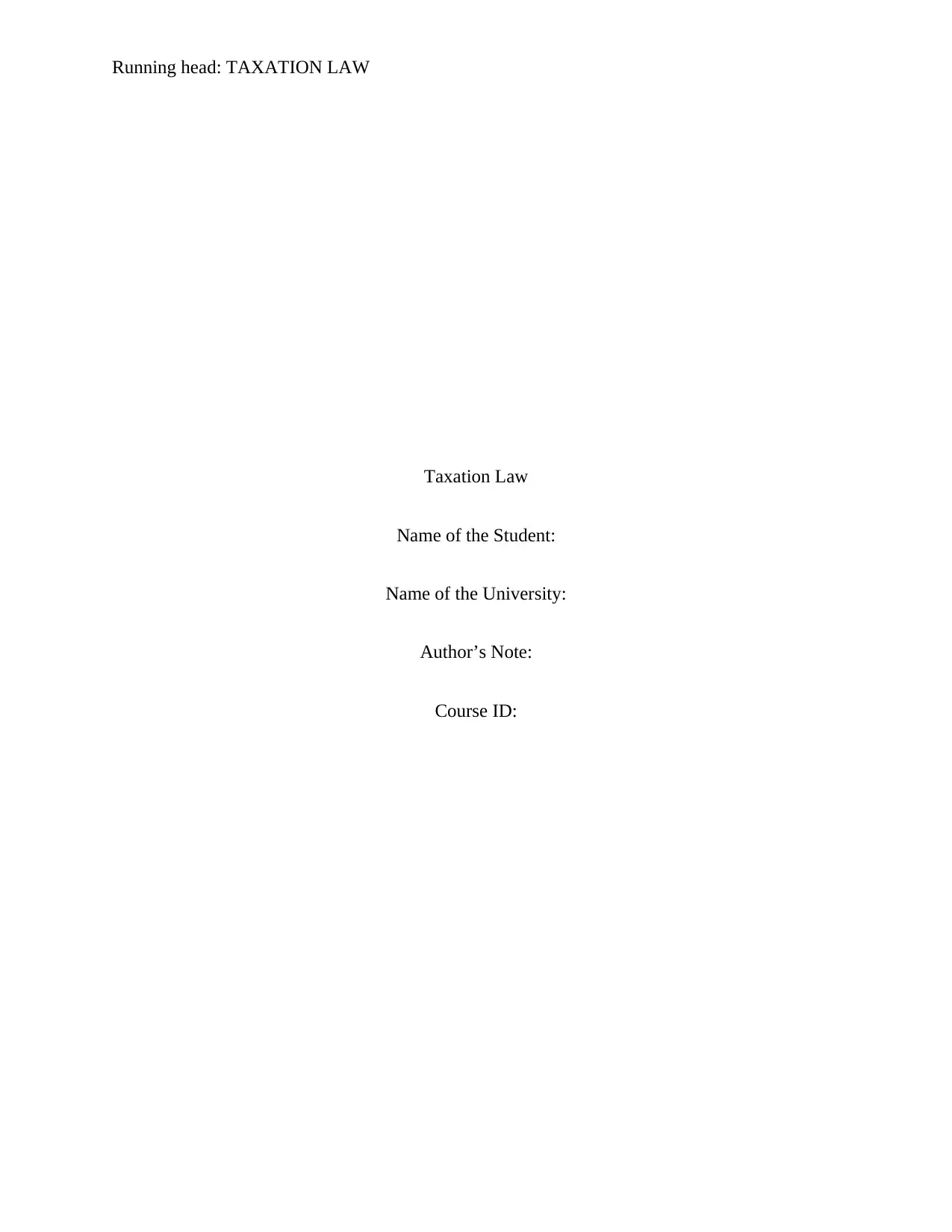
Running head: TAXATION LAW
Taxation Law
Name of the Student:
Name of the University:
Author’s Note:
Course ID:
Taxation Law
Name of the Student:
Name of the University:
Author’s Note:
Course ID:
Paraphrase This Document
Need a fresh take? Get an instant paraphrase of this document with our AI Paraphraser
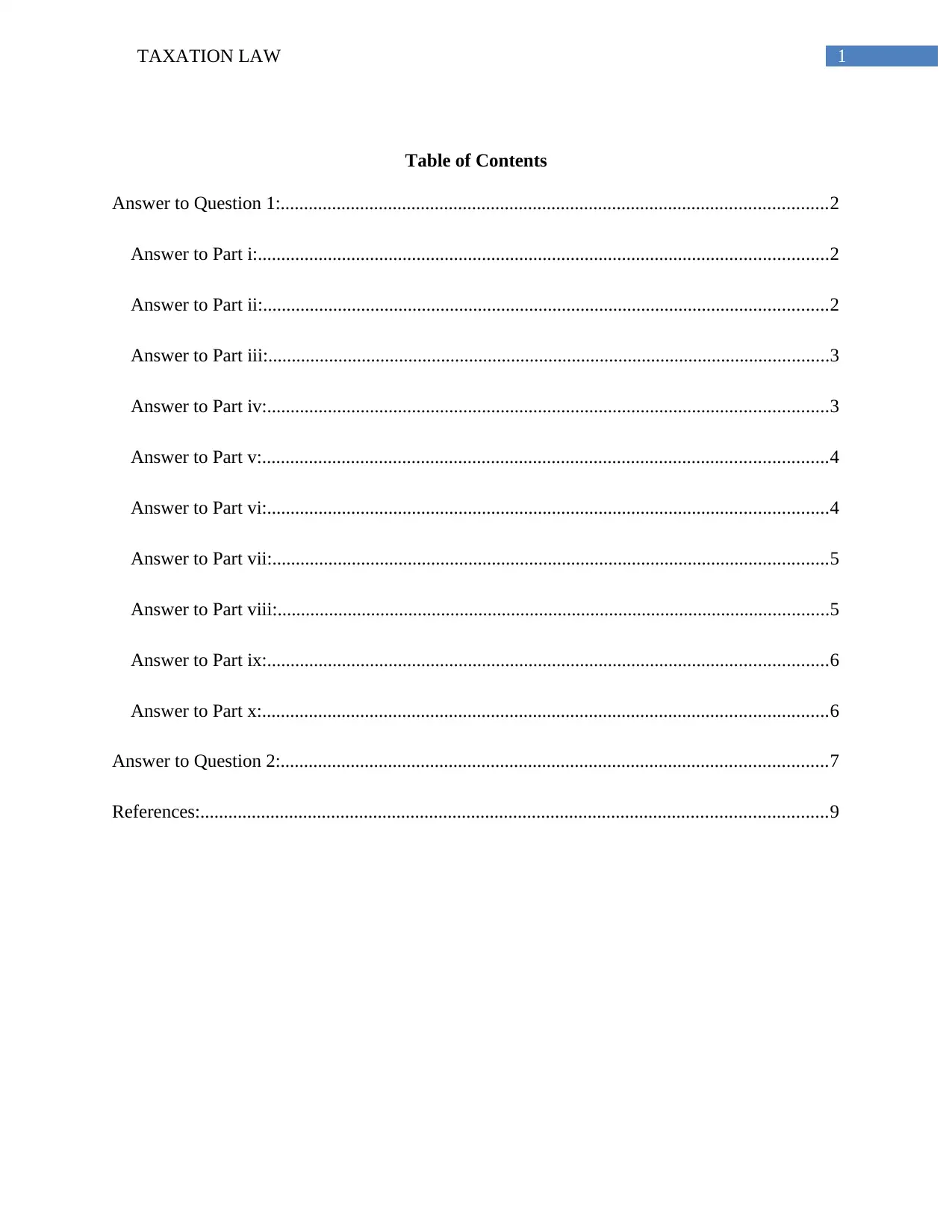
1TAXATION LAW
Table of Contents
Answer to Question 1:.....................................................................................................................2
Answer to Part i:..........................................................................................................................2
Answer to Part ii:.........................................................................................................................2
Answer to Part iii:........................................................................................................................3
Answer to Part iv:........................................................................................................................3
Answer to Part v:.........................................................................................................................4
Answer to Part vi:........................................................................................................................4
Answer to Part vii:.......................................................................................................................5
Answer to Part viii:......................................................................................................................5
Answer to Part ix:........................................................................................................................6
Answer to Part x:.........................................................................................................................6
Answer to Question 2:.....................................................................................................................7
References:......................................................................................................................................9
Table of Contents
Answer to Question 1:.....................................................................................................................2
Answer to Part i:..........................................................................................................................2
Answer to Part ii:.........................................................................................................................2
Answer to Part iii:........................................................................................................................3
Answer to Part iv:........................................................................................................................3
Answer to Part v:.........................................................................................................................4
Answer to Part vi:........................................................................................................................4
Answer to Part vii:.......................................................................................................................5
Answer to Part viii:......................................................................................................................5
Answer to Part ix:........................................................................................................................6
Answer to Part x:.........................................................................................................................6
Answer to Question 2:.....................................................................................................................7
References:......................................................................................................................................9
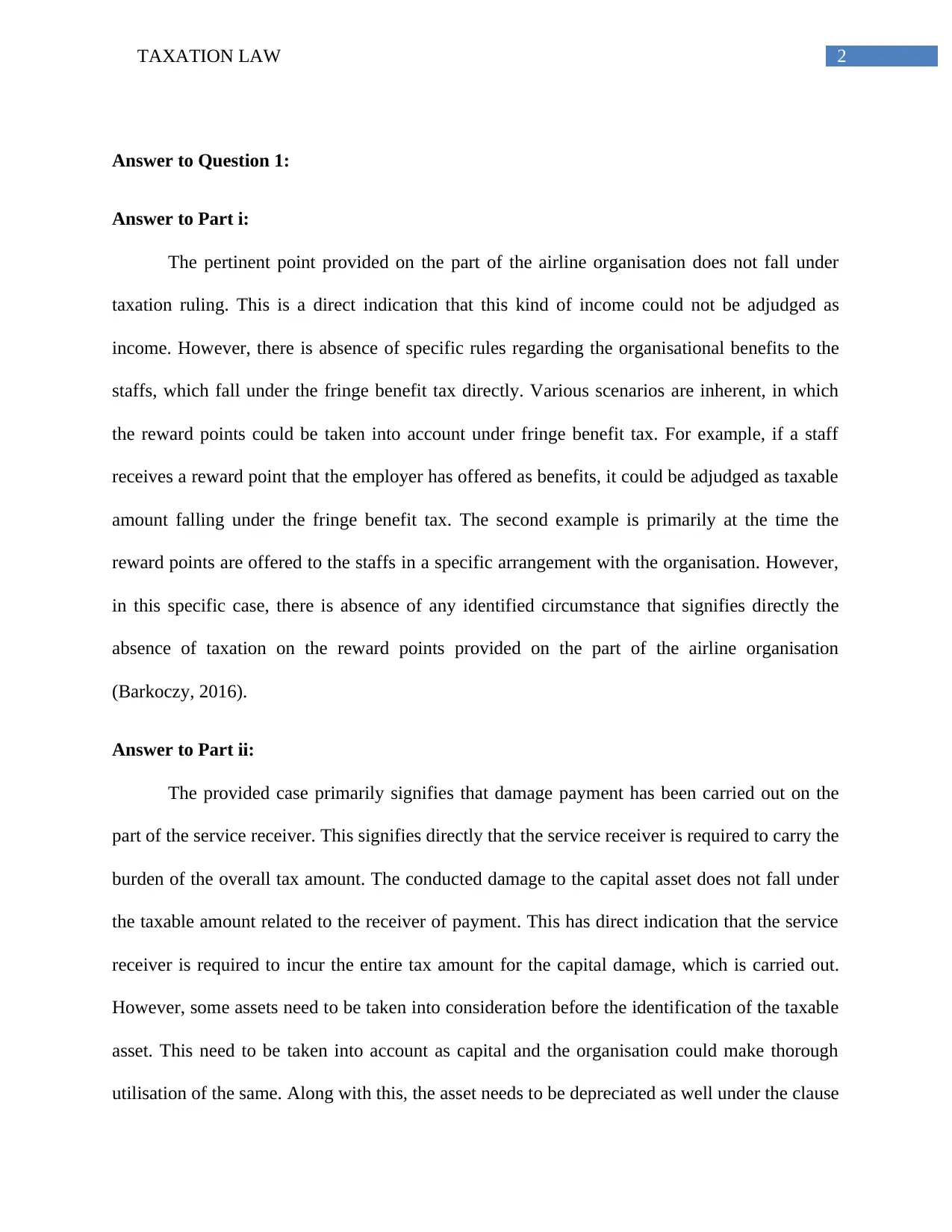
2TAXATION LAW
Answer to Question 1:
Answer to Part i:
The pertinent point provided on the part of the airline organisation does not fall under
taxation ruling. This is a direct indication that this kind of income could not be adjudged as
income. However, there is absence of specific rules regarding the organisational benefits to the
staffs, which fall under the fringe benefit tax directly. Various scenarios are inherent, in which
the reward points could be taken into account under fringe benefit tax. For example, if a staff
receives a reward point that the employer has offered as benefits, it could be adjudged as taxable
amount falling under the fringe benefit tax. The second example is primarily at the time the
reward points are offered to the staffs in a specific arrangement with the organisation. However,
in this specific case, there is absence of any identified circumstance that signifies directly the
absence of taxation on the reward points provided on the part of the airline organisation
(Barkoczy, 2016).
Answer to Part ii:
The provided case primarily signifies that damage payment has been carried out on the
part of the service receiver. This signifies directly that the service receiver is required to carry the
burden of the overall tax amount. The conducted damage to the capital asset does not fall under
the taxable amount related to the receiver of payment. This has direct indication that the service
receiver is required to incur the entire tax amount for the capital damage, which is carried out.
However, some assets need to be taken into consideration before the identification of the taxable
asset. This need to be taken into account as capital and the organisation could make thorough
utilisation of the same. Along with this, the asset needs to be depreciated as well under the clause
Answer to Question 1:
Answer to Part i:
The pertinent point provided on the part of the airline organisation does not fall under
taxation ruling. This is a direct indication that this kind of income could not be adjudged as
income. However, there is absence of specific rules regarding the organisational benefits to the
staffs, which fall under the fringe benefit tax directly. Various scenarios are inherent, in which
the reward points could be taken into account under fringe benefit tax. For example, if a staff
receives a reward point that the employer has offered as benefits, it could be adjudged as taxable
amount falling under the fringe benefit tax. The second example is primarily at the time the
reward points are offered to the staffs in a specific arrangement with the organisation. However,
in this specific case, there is absence of any identified circumstance that signifies directly the
absence of taxation on the reward points provided on the part of the airline organisation
(Barkoczy, 2016).
Answer to Part ii:
The provided case primarily signifies that damage payment has been carried out on the
part of the service receiver. This signifies directly that the service receiver is required to carry the
burden of the overall tax amount. The conducted damage to the capital asset does not fall under
the taxable amount related to the receiver of payment. This has direct indication that the service
receiver is required to incur the entire tax amount for the capital damage, which is carried out.
However, some assets need to be taken into consideration before the identification of the taxable
asset. This need to be taken into account as capital and the organisation could make thorough
utilisation of the same. Along with this, the asset needs to be depreciated as well under the clause
⊘ This is a preview!⊘
Do you want full access?
Subscribe today to unlock all pages.

Trusted by 1+ million students worldwide
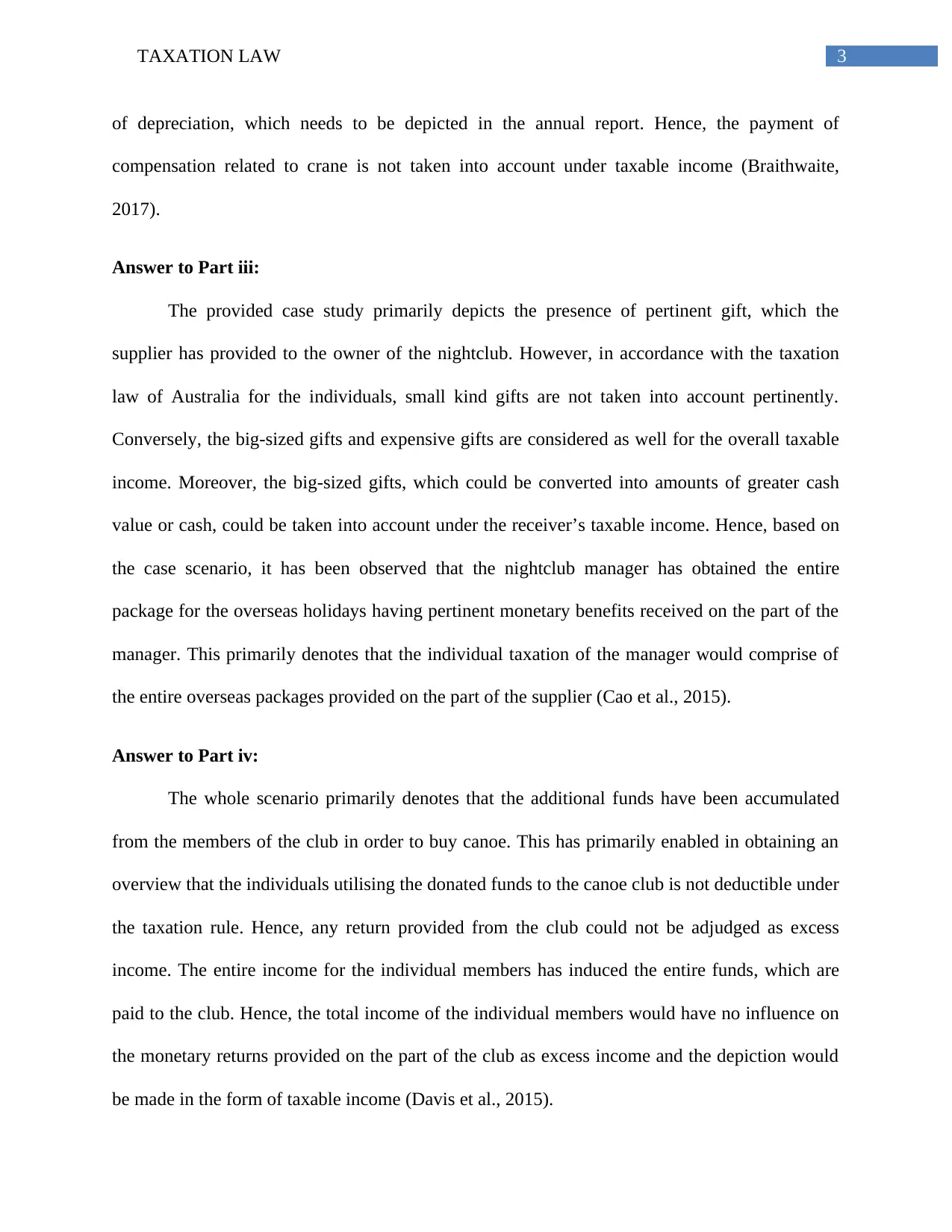
3TAXATION LAW
of depreciation, which needs to be depicted in the annual report. Hence, the payment of
compensation related to crane is not taken into account under taxable income (Braithwaite,
2017).
Answer to Part iii:
The provided case study primarily depicts the presence of pertinent gift, which the
supplier has provided to the owner of the nightclub. However, in accordance with the taxation
law of Australia for the individuals, small kind gifts are not taken into account pertinently.
Conversely, the big-sized gifts and expensive gifts are considered as well for the overall taxable
income. Moreover, the big-sized gifts, which could be converted into amounts of greater cash
value or cash, could be taken into account under the receiver’s taxable income. Hence, based on
the case scenario, it has been observed that the nightclub manager has obtained the entire
package for the overseas holidays having pertinent monetary benefits received on the part of the
manager. This primarily denotes that the individual taxation of the manager would comprise of
the entire overseas packages provided on the part of the supplier (Cao et al., 2015).
Answer to Part iv:
The whole scenario primarily denotes that the additional funds have been accumulated
from the members of the club in order to buy canoe. This has primarily enabled in obtaining an
overview that the individuals utilising the donated funds to the canoe club is not deductible under
the taxation rule. Hence, any return provided from the club could not be adjudged as excess
income. The entire income for the individual members has induced the entire funds, which are
paid to the club. Hence, the total income of the individual members would have no influence on
the monetary returns provided on the part of the club as excess income and the depiction would
be made in the form of taxable income (Davis et al., 2015).
of depreciation, which needs to be depicted in the annual report. Hence, the payment of
compensation related to crane is not taken into account under taxable income (Braithwaite,
2017).
Answer to Part iii:
The provided case study primarily depicts the presence of pertinent gift, which the
supplier has provided to the owner of the nightclub. However, in accordance with the taxation
law of Australia for the individuals, small kind gifts are not taken into account pertinently.
Conversely, the big-sized gifts and expensive gifts are considered as well for the overall taxable
income. Moreover, the big-sized gifts, which could be converted into amounts of greater cash
value or cash, could be taken into account under the receiver’s taxable income. Hence, based on
the case scenario, it has been observed that the nightclub manager has obtained the entire
package for the overseas holidays having pertinent monetary benefits received on the part of the
manager. This primarily denotes that the individual taxation of the manager would comprise of
the entire overseas packages provided on the part of the supplier (Cao et al., 2015).
Answer to Part iv:
The whole scenario primarily denotes that the additional funds have been accumulated
from the members of the club in order to buy canoe. This has primarily enabled in obtaining an
overview that the individuals utilising the donated funds to the canoe club is not deductible under
the taxation rule. Hence, any return provided from the club could not be adjudged as excess
income. The entire income for the individual members has induced the entire funds, which are
paid to the club. Hence, the total income of the individual members would have no influence on
the monetary returns provided on the part of the club as excess income and the depiction would
be made in the form of taxable income (Davis et al., 2015).
Paraphrase This Document
Need a fresh take? Get an instant paraphrase of this document with our AI Paraphraser
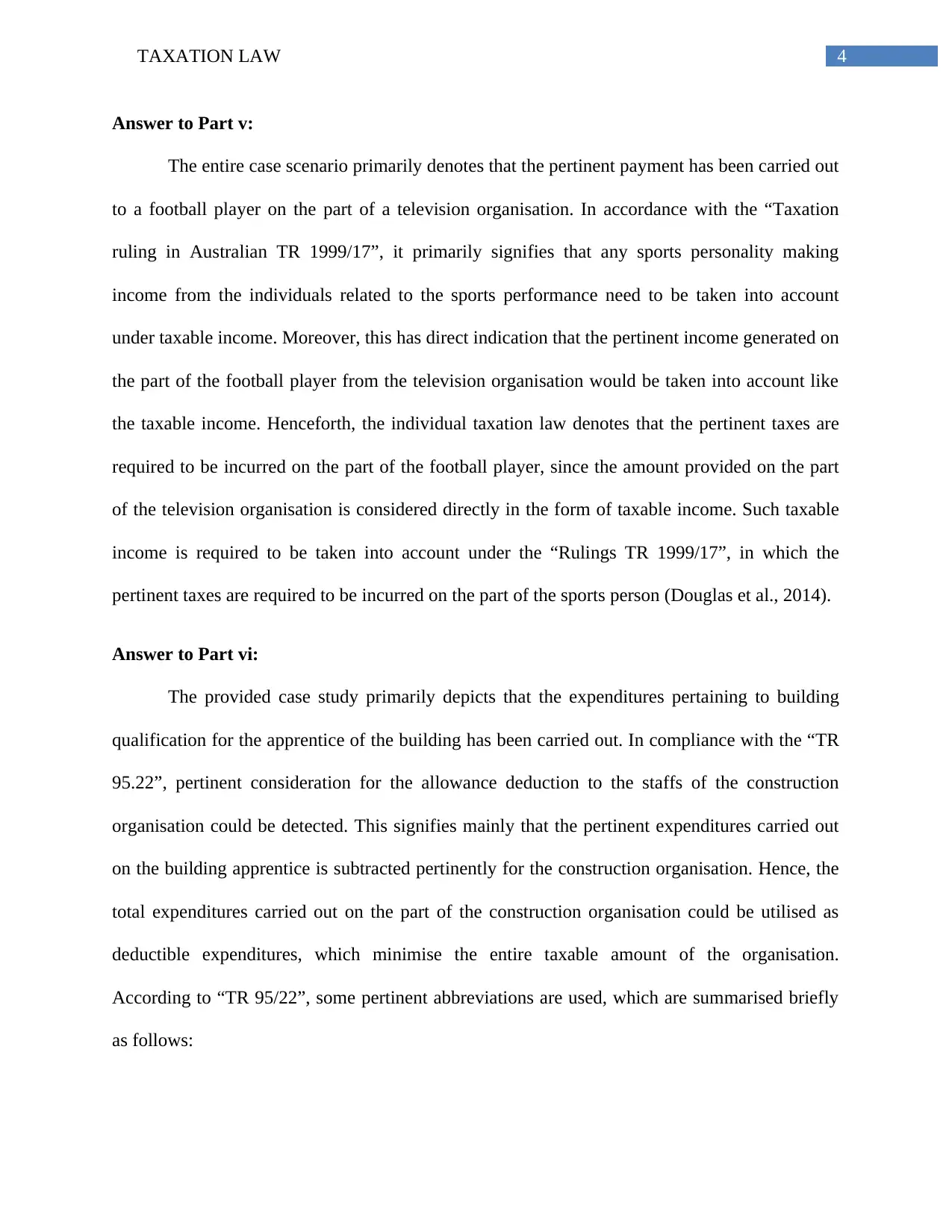
4TAXATION LAW
Answer to Part v:
The entire case scenario primarily denotes that the pertinent payment has been carried out
to a football player on the part of a television organisation. In accordance with the “Taxation
ruling in Australian TR 1999/17”, it primarily signifies that any sports personality making
income from the individuals related to the sports performance need to be taken into account
under taxable income. Moreover, this has direct indication that the pertinent income generated on
the part of the football player from the television organisation would be taken into account like
the taxable income. Henceforth, the individual taxation law denotes that the pertinent taxes are
required to be incurred on the part of the football player, since the amount provided on the part
of the television organisation is considered directly in the form of taxable income. Such taxable
income is required to be taken into account under the “Rulings TR 1999/17”, in which the
pertinent taxes are required to be incurred on the part of the sports person (Douglas et al., 2014).
Answer to Part vi:
The provided case study primarily depicts that the expenditures pertaining to building
qualification for the apprentice of the building has been carried out. In compliance with the “TR
95.22”, pertinent consideration for the allowance deduction to the staffs of the construction
organisation could be detected. This signifies mainly that the pertinent expenditures carried out
on the building apprentice is subtracted pertinently for the construction organisation. Hence, the
total expenditures carried out on the part of the construction organisation could be utilised as
deductible expenditures, which minimise the entire taxable amount of the organisation.
According to “TR 95/22”, some pertinent abbreviations are used, which are summarised briefly
as follows:
Answer to Part v:
The entire case scenario primarily denotes that the pertinent payment has been carried out
to a football player on the part of a television organisation. In accordance with the “Taxation
ruling in Australian TR 1999/17”, it primarily signifies that any sports personality making
income from the individuals related to the sports performance need to be taken into account
under taxable income. Moreover, this has direct indication that the pertinent income generated on
the part of the football player from the television organisation would be taken into account like
the taxable income. Henceforth, the individual taxation law denotes that the pertinent taxes are
required to be incurred on the part of the football player, since the amount provided on the part
of the television organisation is considered directly in the form of taxable income. Such taxable
income is required to be taken into account under the “Rulings TR 1999/17”, in which the
pertinent taxes are required to be incurred on the part of the sports person (Douglas et al., 2014).
Answer to Part vi:
The provided case study primarily depicts that the expenditures pertaining to building
qualification for the apprentice of the building has been carried out. In compliance with the “TR
95.22”, pertinent consideration for the allowance deduction to the staffs of the construction
organisation could be detected. This signifies mainly that the pertinent expenditures carried out
on the building apprentice is subtracted pertinently for the construction organisation. Hence, the
total expenditures carried out on the part of the construction organisation could be utilised as
deductible expenditures, which minimise the entire taxable amount of the organisation.
According to “TR 95/22”, some pertinent abbreviations are used, which are summarised briefly
as follows:
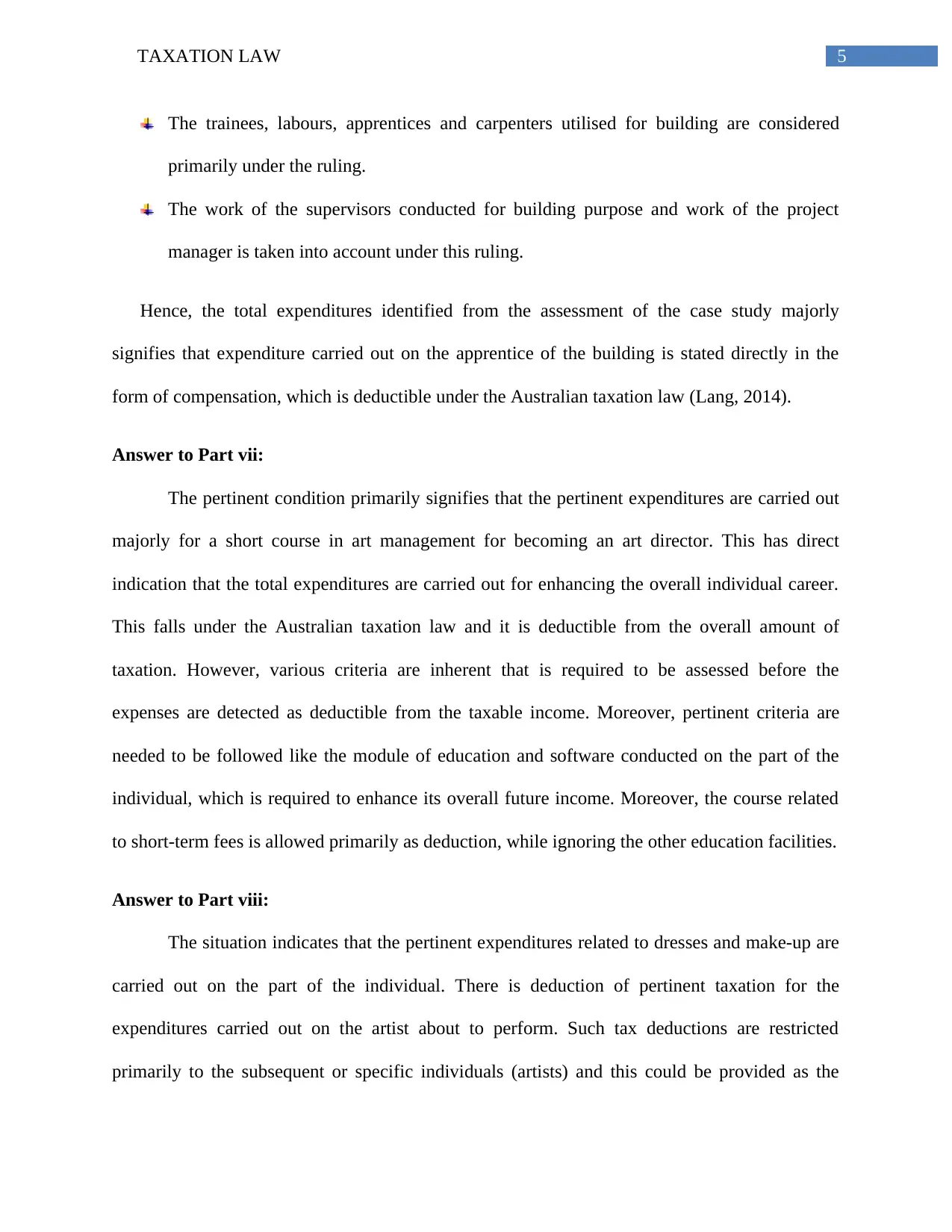
5TAXATION LAW
The trainees, labours, apprentices and carpenters utilised for building are considered
primarily under the ruling.
The work of the supervisors conducted for building purpose and work of the project
manager is taken into account under this ruling.
Hence, the total expenditures identified from the assessment of the case study majorly
signifies that expenditure carried out on the apprentice of the building is stated directly in the
form of compensation, which is deductible under the Australian taxation law (Lang, 2014).
Answer to Part vii:
The pertinent condition primarily signifies that the pertinent expenditures are carried out
majorly for a short course in art management for becoming an art director. This has direct
indication that the total expenditures are carried out for enhancing the overall individual career.
This falls under the Australian taxation law and it is deductible from the overall amount of
taxation. However, various criteria are inherent that is required to be assessed before the
expenses are detected as deductible from the taxable income. Moreover, pertinent criteria are
needed to be followed like the module of education and software conducted on the part of the
individual, which is required to enhance its overall future income. Moreover, the course related
to short-term fees is allowed primarily as deduction, while ignoring the other education facilities.
Answer to Part viii:
The situation indicates that the pertinent expenditures related to dresses and make-up are
carried out on the part of the individual. There is deduction of pertinent taxation for the
expenditures carried out on the artist about to perform. Such tax deductions are restricted
primarily to the subsequent or specific individuals (artists) and this could be provided as the
The trainees, labours, apprentices and carpenters utilised for building are considered
primarily under the ruling.
The work of the supervisors conducted for building purpose and work of the project
manager is taken into account under this ruling.
Hence, the total expenditures identified from the assessment of the case study majorly
signifies that expenditure carried out on the apprentice of the building is stated directly in the
form of compensation, which is deductible under the Australian taxation law (Lang, 2014).
Answer to Part vii:
The pertinent condition primarily signifies that the pertinent expenditures are carried out
majorly for a short course in art management for becoming an art director. This has direct
indication that the total expenditures are carried out for enhancing the overall individual career.
This falls under the Australian taxation law and it is deductible from the overall amount of
taxation. However, various criteria are inherent that is required to be assessed before the
expenses are detected as deductible from the taxable income. Moreover, pertinent criteria are
needed to be followed like the module of education and software conducted on the part of the
individual, which is required to enhance its overall future income. Moreover, the course related
to short-term fees is allowed primarily as deduction, while ignoring the other education facilities.
Answer to Part viii:
The situation indicates that the pertinent expenditures related to dresses and make-up are
carried out on the part of the individual. There is deduction of pertinent taxation for the
expenditures carried out on the artist about to perform. Such tax deductions are restricted
primarily to the subsequent or specific individuals (artists) and this could be provided as the
⊘ This is a preview!⊘
Do you want full access?
Subscribe today to unlock all pages.

Trusted by 1+ million students worldwide
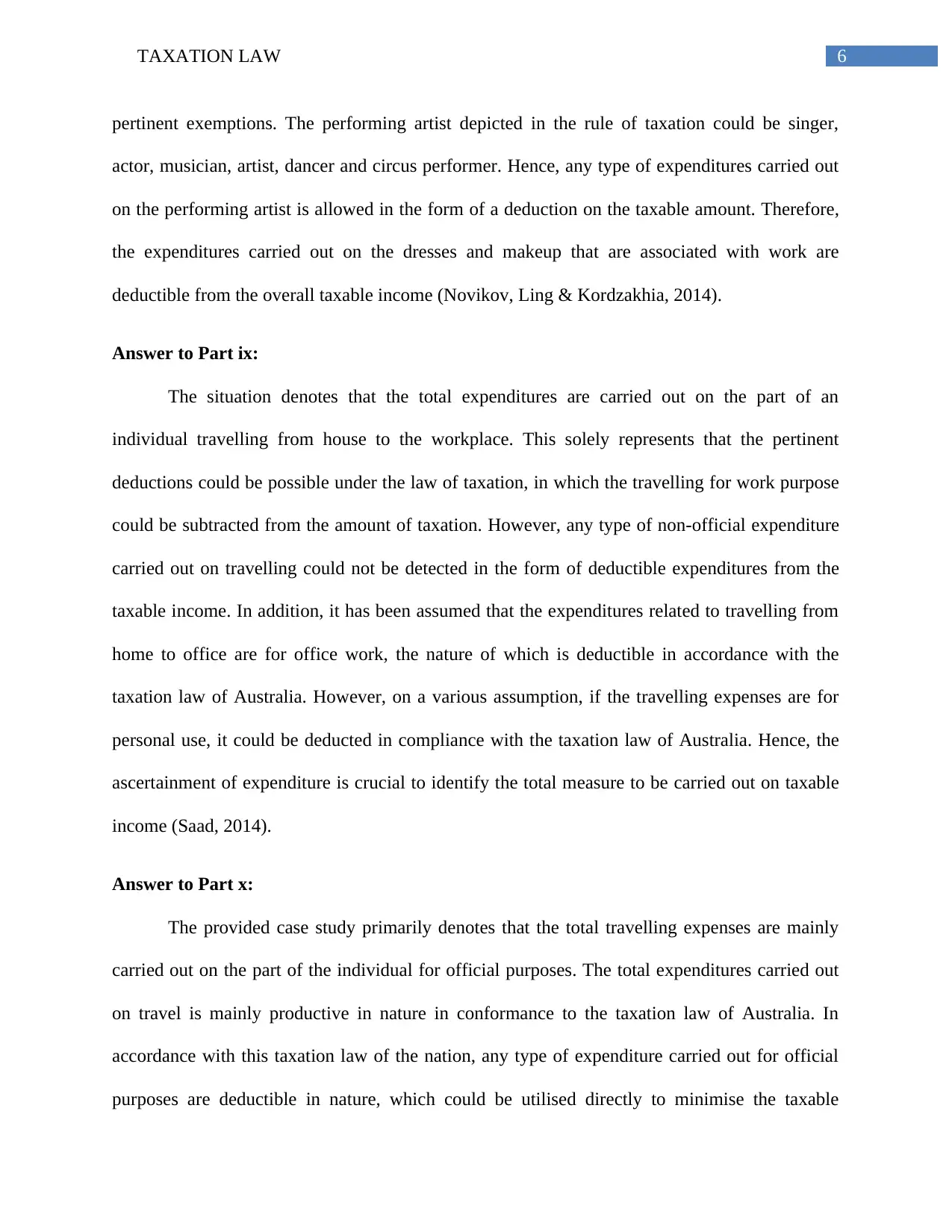
6TAXATION LAW
pertinent exemptions. The performing artist depicted in the rule of taxation could be singer,
actor, musician, artist, dancer and circus performer. Hence, any type of expenditures carried out
on the performing artist is allowed in the form of a deduction on the taxable amount. Therefore,
the expenditures carried out on the dresses and makeup that are associated with work are
deductible from the overall taxable income (Novikov, Ling & Kordzakhia, 2014).
Answer to Part ix:
The situation denotes that the total expenditures are carried out on the part of an
individual travelling from house to the workplace. This solely represents that the pertinent
deductions could be possible under the law of taxation, in which the travelling for work purpose
could be subtracted from the amount of taxation. However, any type of non-official expenditure
carried out on travelling could not be detected in the form of deductible expenditures from the
taxable income. In addition, it has been assumed that the expenditures related to travelling from
home to office are for office work, the nature of which is deductible in accordance with the
taxation law of Australia. However, on a various assumption, if the travelling expenses are for
personal use, it could be deducted in compliance with the taxation law of Australia. Hence, the
ascertainment of expenditure is crucial to identify the total measure to be carried out on taxable
income (Saad, 2014).
Answer to Part x:
The provided case study primarily denotes that the total travelling expenses are mainly
carried out on the part of the individual for official purposes. The total expenditures carried out
on travel is mainly productive in nature in conformance to the taxation law of Australia. In
accordance with this taxation law of the nation, any type of expenditure carried out for official
purposes are deductible in nature, which could be utilised directly to minimise the taxable
pertinent exemptions. The performing artist depicted in the rule of taxation could be singer,
actor, musician, artist, dancer and circus performer. Hence, any type of expenditures carried out
on the performing artist is allowed in the form of a deduction on the taxable amount. Therefore,
the expenditures carried out on the dresses and makeup that are associated with work are
deductible from the overall taxable income (Novikov, Ling & Kordzakhia, 2014).
Answer to Part ix:
The situation denotes that the total expenditures are carried out on the part of an
individual travelling from house to the workplace. This solely represents that the pertinent
deductions could be possible under the law of taxation, in which the travelling for work purpose
could be subtracted from the amount of taxation. However, any type of non-official expenditure
carried out on travelling could not be detected in the form of deductible expenditures from the
taxable income. In addition, it has been assumed that the expenditures related to travelling from
home to office are for office work, the nature of which is deductible in accordance with the
taxation law of Australia. However, on a various assumption, if the travelling expenses are for
personal use, it could be deducted in compliance with the taxation law of Australia. Hence, the
ascertainment of expenditure is crucial to identify the total measure to be carried out on taxable
income (Saad, 2014).
Answer to Part x:
The provided case study primarily denotes that the total travelling expenses are mainly
carried out on the part of the individual for official purposes. The total expenditures carried out
on travel is mainly productive in nature in conformance to the taxation law of Australia. In
accordance with this taxation law of the nation, any type of expenditure carried out for official
purposes are deductible in nature, which could be utilised directly to minimise the taxable
Paraphrase This Document
Need a fresh take? Get an instant paraphrase of this document with our AI Paraphraser
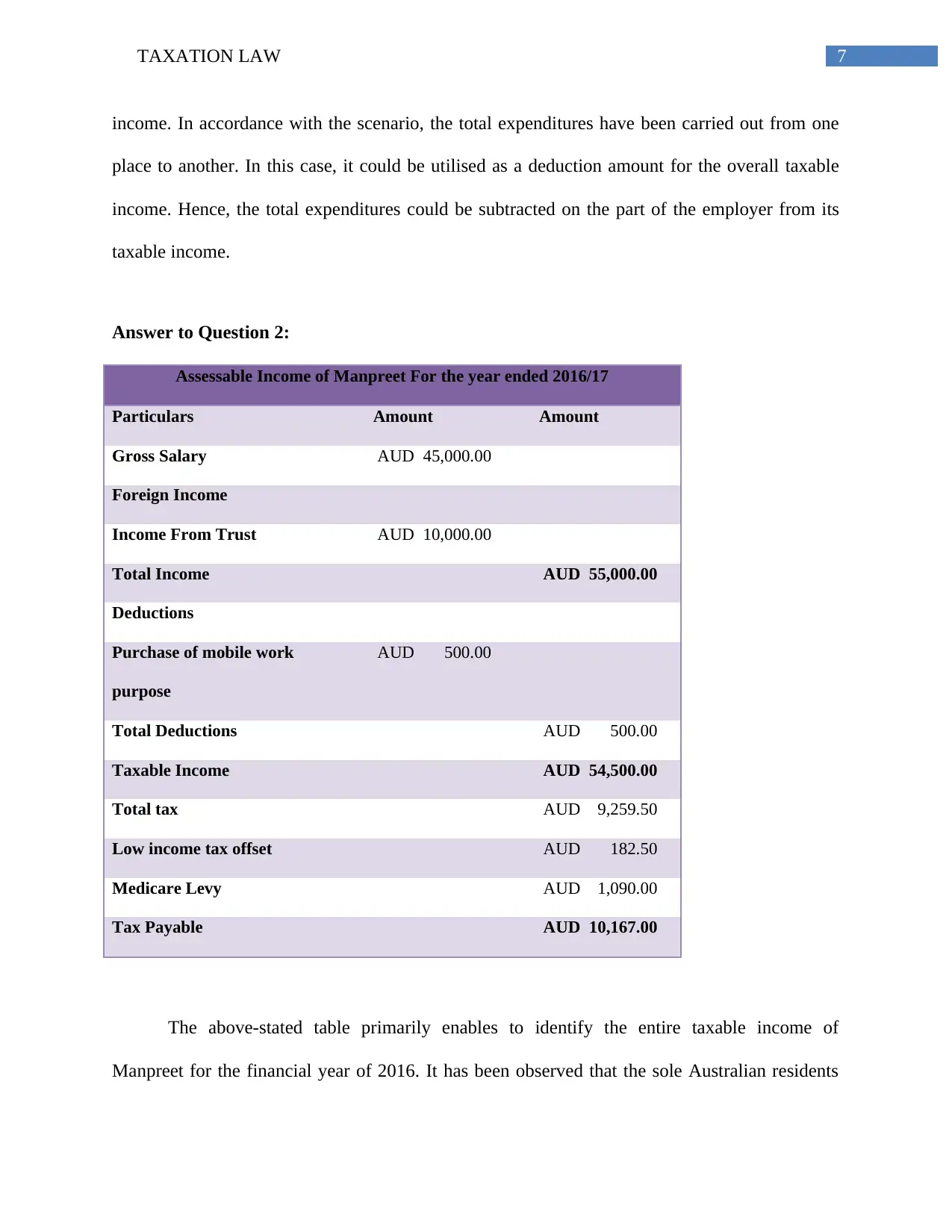
7TAXATION LAW
income. In accordance with the scenario, the total expenditures have been carried out from one
place to another. In this case, it could be utilised as a deduction amount for the overall taxable
income. Hence, the total expenditures could be subtracted on the part of the employer from its
taxable income.
Answer to Question 2:
Assessable Income of Manpreet For the year ended 2016/17
Particulars Amount Amount
Gross Salary AUD 45,000.00
Foreign Income
Income From Trust AUD 10,000.00
Total Income AUD 55,000.00
Deductions
Purchase of mobile work
purpose
AUD 500.00
Total Deductions AUD 500.00
Taxable Income AUD 54,500.00
Total tax AUD 9,259.50
Low income tax offset AUD 182.50
Medicare Levy AUD 1,090.00
Tax Payable AUD 10,167.00
The above-stated table primarily enables to identify the entire taxable income of
Manpreet for the financial year of 2016. It has been observed that the sole Australian residents
income. In accordance with the scenario, the total expenditures have been carried out from one
place to another. In this case, it could be utilised as a deduction amount for the overall taxable
income. Hence, the total expenditures could be subtracted on the part of the employer from its
taxable income.
Answer to Question 2:
Assessable Income of Manpreet For the year ended 2016/17
Particulars Amount Amount
Gross Salary AUD 45,000.00
Foreign Income
Income From Trust AUD 10,000.00
Total Income AUD 55,000.00
Deductions
Purchase of mobile work
purpose
AUD 500.00
Total Deductions AUD 500.00
Taxable Income AUD 54,500.00
Total tax AUD 9,259.50
Low income tax offset AUD 182.50
Medicare Levy AUD 1,090.00
Tax Payable AUD 10,167.00
The above-stated table primarily enables to identify the entire taxable income of
Manpreet for the financial year of 2016. It has been observed that the sole Australian residents
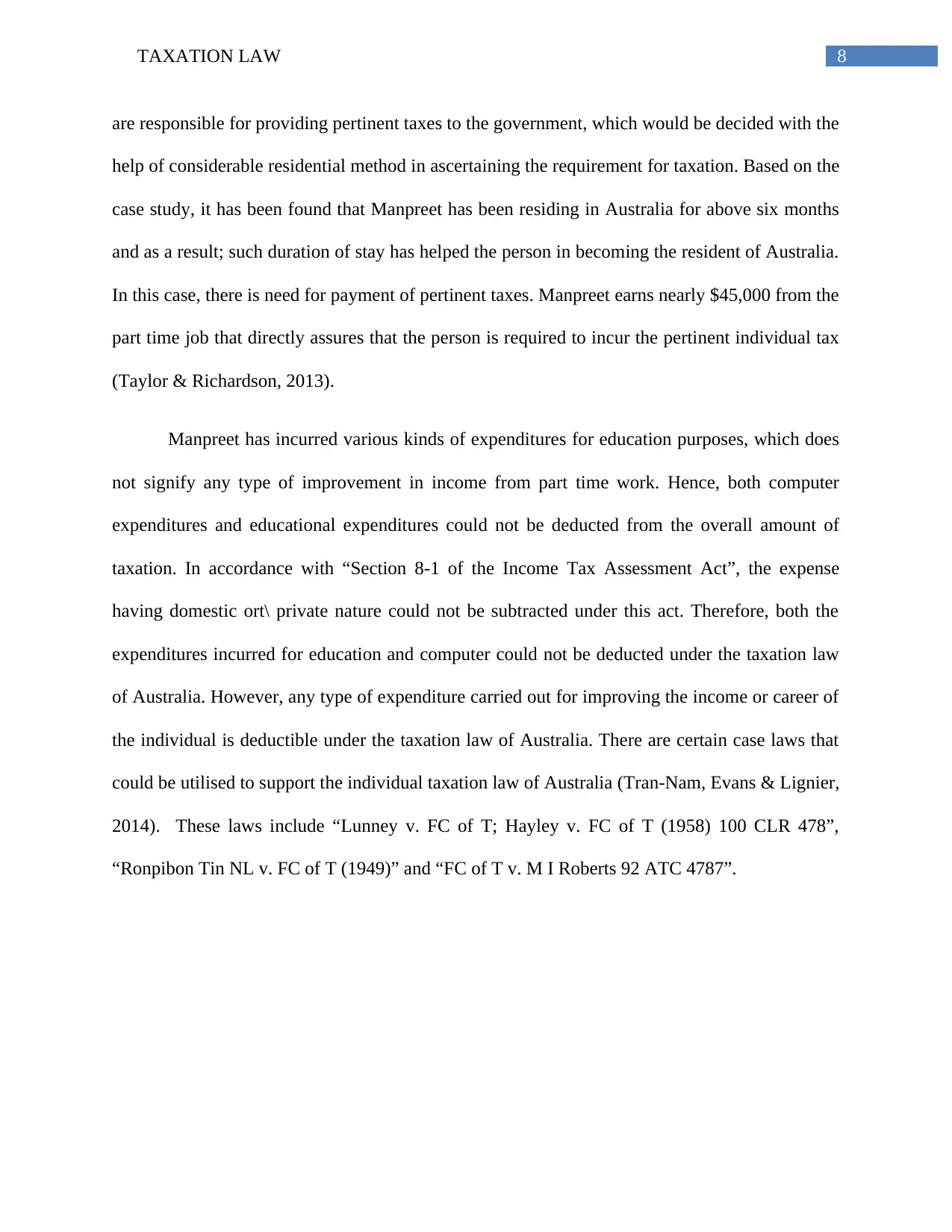
8TAXATION LAW
are responsible for providing pertinent taxes to the government, which would be decided with the
help of considerable residential method in ascertaining the requirement for taxation. Based on the
case study, it has been found that Manpreet has been residing in Australia for above six months
and as a result; such duration of stay has helped the person in becoming the resident of Australia.
In this case, there is need for payment of pertinent taxes. Manpreet earns nearly $45,000 from the
part time job that directly assures that the person is required to incur the pertinent individual tax
(Taylor & Richardson, 2013).
Manpreet has incurred various kinds of expenditures for education purposes, which does
not signify any type of improvement in income from part time work. Hence, both computer
expenditures and educational expenditures could not be deducted from the overall amount of
taxation. In accordance with “Section 8-1 of the Income Tax Assessment Act”, the expense
having domestic ort\ private nature could not be subtracted under this act. Therefore, both the
expenditures incurred for education and computer could not be deducted under the taxation law
of Australia. However, any type of expenditure carried out for improving the income or career of
the individual is deductible under the taxation law of Australia. There are certain case laws that
could be utilised to support the individual taxation law of Australia (Tran-Nam, Evans & Lignier,
2014). These laws include “Lunney v. FC of T; Hayley v. FC of T (1958) 100 CLR 478”,
“Ronpibon Tin NL v. FC of T (1949)” and “FC of T v. M I Roberts 92 ATC 4787”.
are responsible for providing pertinent taxes to the government, which would be decided with the
help of considerable residential method in ascertaining the requirement for taxation. Based on the
case study, it has been found that Manpreet has been residing in Australia for above six months
and as a result; such duration of stay has helped the person in becoming the resident of Australia.
In this case, there is need for payment of pertinent taxes. Manpreet earns nearly $45,000 from the
part time job that directly assures that the person is required to incur the pertinent individual tax
(Taylor & Richardson, 2013).
Manpreet has incurred various kinds of expenditures for education purposes, which does
not signify any type of improvement in income from part time work. Hence, both computer
expenditures and educational expenditures could not be deducted from the overall amount of
taxation. In accordance with “Section 8-1 of the Income Tax Assessment Act”, the expense
having domestic ort\ private nature could not be subtracted under this act. Therefore, both the
expenditures incurred for education and computer could not be deducted under the taxation law
of Australia. However, any type of expenditure carried out for improving the income or career of
the individual is deductible under the taxation law of Australia. There are certain case laws that
could be utilised to support the individual taxation law of Australia (Tran-Nam, Evans & Lignier,
2014). These laws include “Lunney v. FC of T; Hayley v. FC of T (1958) 100 CLR 478”,
“Ronpibon Tin NL v. FC of T (1949)” and “FC of T v. M I Roberts 92 ATC 4787”.
⊘ This is a preview!⊘
Do you want full access?
Subscribe today to unlock all pages.

Trusted by 1+ million students worldwide
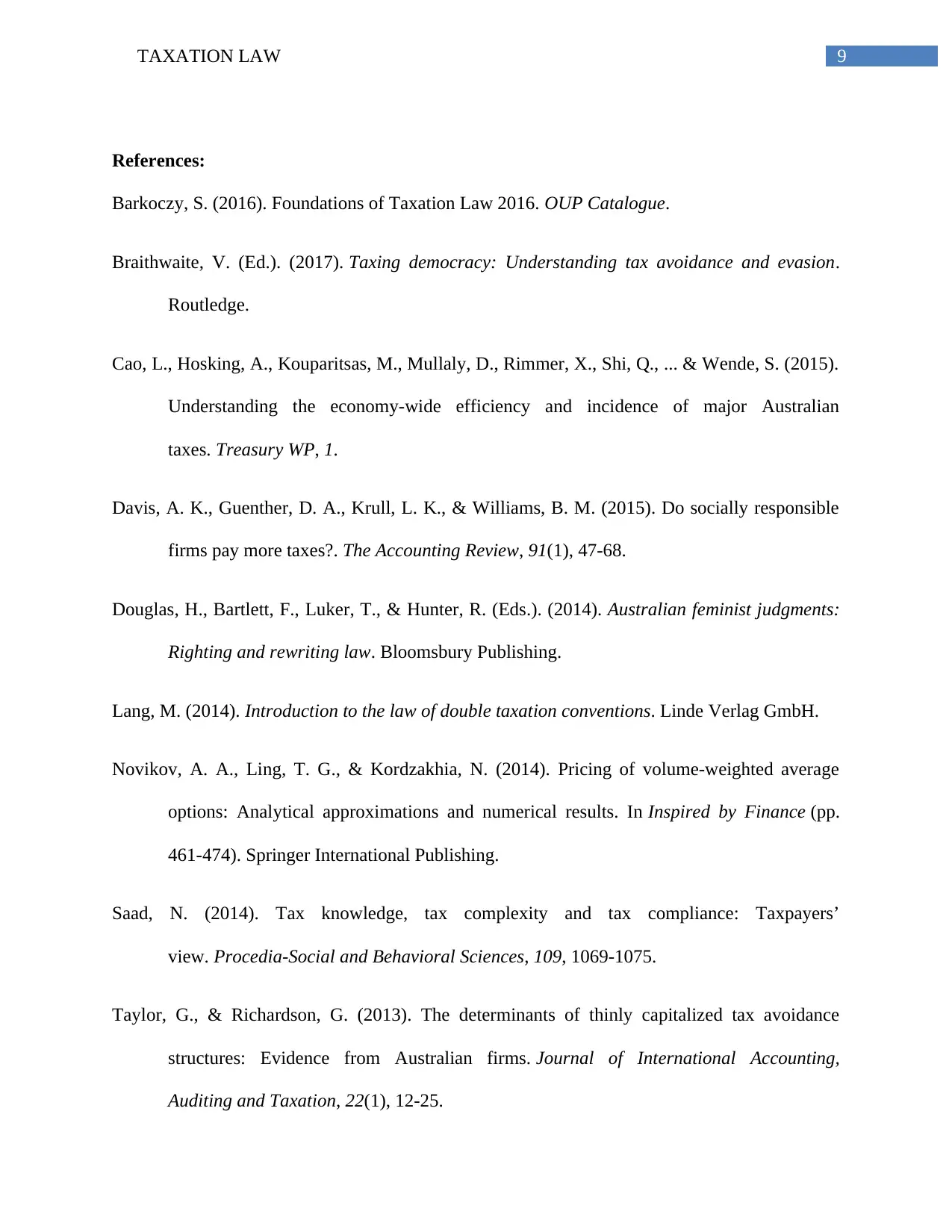
9TAXATION LAW
References:
Barkoczy, S. (2016). Foundations of Taxation Law 2016. OUP Catalogue.
Braithwaite, V. (Ed.). (2017). Taxing democracy: Understanding tax avoidance and evasion.
Routledge.
Cao, L., Hosking, A., Kouparitsas, M., Mullaly, D., Rimmer, X., Shi, Q., ... & Wende, S. (2015).
Understanding the economy-wide efficiency and incidence of major Australian
taxes. Treasury WP, 1.
Davis, A. K., Guenther, D. A., Krull, L. K., & Williams, B. M. (2015). Do socially responsible
firms pay more taxes?. The Accounting Review, 91(1), 47-68.
Douglas, H., Bartlett, F., Luker, T., & Hunter, R. (Eds.). (2014). Australian feminist judgments:
Righting and rewriting law. Bloomsbury Publishing.
Lang, M. (2014). Introduction to the law of double taxation conventions. Linde Verlag GmbH.
Novikov, A. A., Ling, T. G., & Kordzakhia, N. (2014). Pricing of volume-weighted average
options: Analytical approximations and numerical results. In Inspired by Finance (pp.
461-474). Springer International Publishing.
Saad, N. (2014). Tax knowledge, tax complexity and tax compliance: Taxpayers’
view. Procedia-Social and Behavioral Sciences, 109, 1069-1075.
Taylor, G., & Richardson, G. (2013). The determinants of thinly capitalized tax avoidance
structures: Evidence from Australian firms. Journal of International Accounting,
Auditing and Taxation, 22(1), 12-25.
References:
Barkoczy, S. (2016). Foundations of Taxation Law 2016. OUP Catalogue.
Braithwaite, V. (Ed.). (2017). Taxing democracy: Understanding tax avoidance and evasion.
Routledge.
Cao, L., Hosking, A., Kouparitsas, M., Mullaly, D., Rimmer, X., Shi, Q., ... & Wende, S. (2015).
Understanding the economy-wide efficiency and incidence of major Australian
taxes. Treasury WP, 1.
Davis, A. K., Guenther, D. A., Krull, L. K., & Williams, B. M. (2015). Do socially responsible
firms pay more taxes?. The Accounting Review, 91(1), 47-68.
Douglas, H., Bartlett, F., Luker, T., & Hunter, R. (Eds.). (2014). Australian feminist judgments:
Righting and rewriting law. Bloomsbury Publishing.
Lang, M. (2014). Introduction to the law of double taxation conventions. Linde Verlag GmbH.
Novikov, A. A., Ling, T. G., & Kordzakhia, N. (2014). Pricing of volume-weighted average
options: Analytical approximations and numerical results. In Inspired by Finance (pp.
461-474). Springer International Publishing.
Saad, N. (2014). Tax knowledge, tax complexity and tax compliance: Taxpayers’
view. Procedia-Social and Behavioral Sciences, 109, 1069-1075.
Taylor, G., & Richardson, G. (2013). The determinants of thinly capitalized tax avoidance
structures: Evidence from Australian firms. Journal of International Accounting,
Auditing and Taxation, 22(1), 12-25.
Paraphrase This Document
Need a fresh take? Get an instant paraphrase of this document with our AI Paraphraser
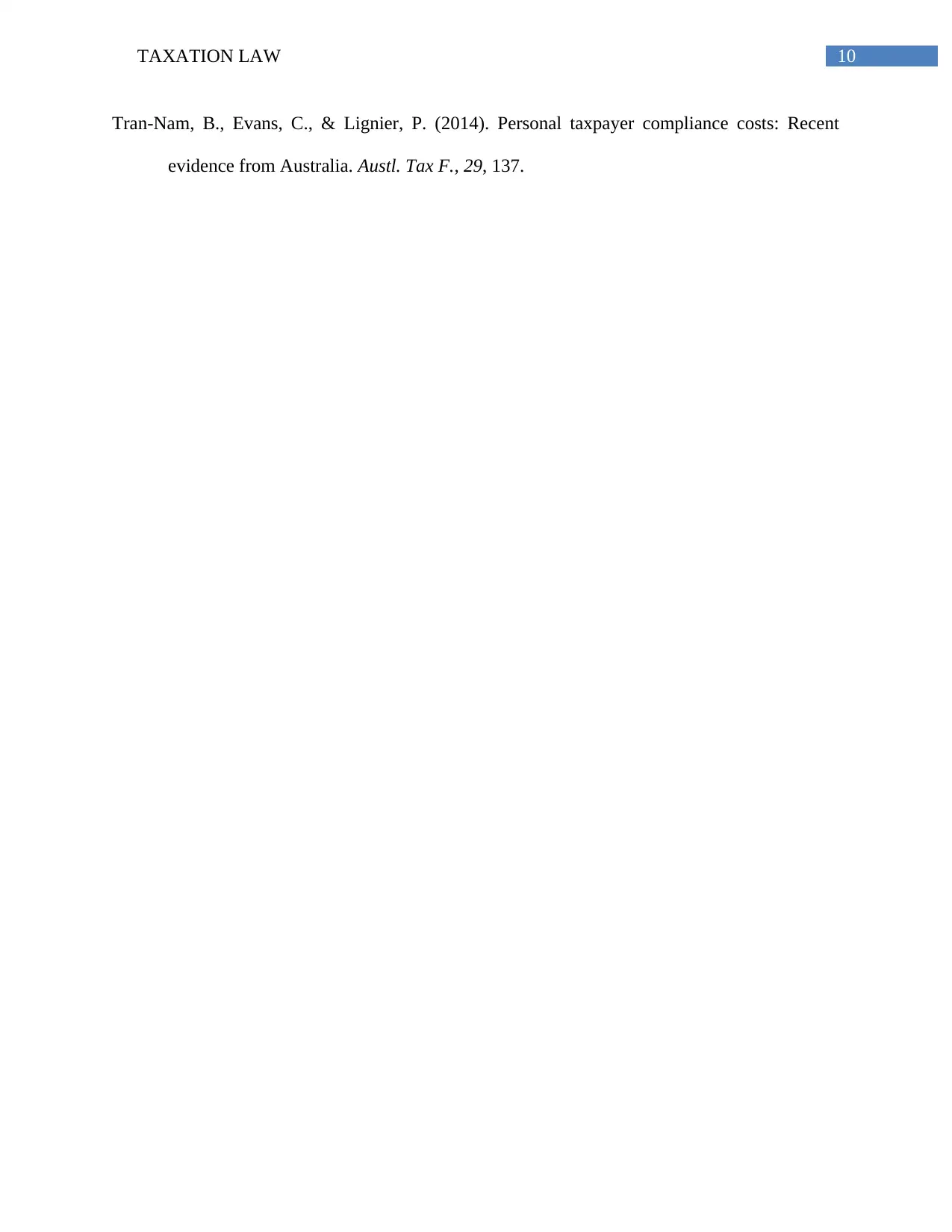
10TAXATION LAW
Tran-Nam, B., Evans, C., & Lignier, P. (2014). Personal taxpayer compliance costs: Recent
evidence from Australia. Austl. Tax F., 29, 137.
Tran-Nam, B., Evans, C., & Lignier, P. (2014). Personal taxpayer compliance costs: Recent
evidence from Australia. Austl. Tax F., 29, 137.
1 out of 11
Related Documents
Your All-in-One AI-Powered Toolkit for Academic Success.
+13062052269
info@desklib.com
Available 24*7 on WhatsApp / Email
![[object Object]](/_next/static/media/star-bottom.7253800d.svg)
Unlock your academic potential
Copyright © 2020–2025 A2Z Services. All Rights Reserved. Developed and managed by ZUCOL.





